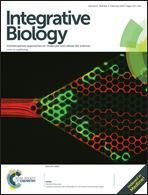Stoichiometric control of live cell mixing to enable fluidically-encoded co-culture models in perfused microbioreactor arrays†
Abstract
In vivo, tissues are maintained and repaired through interactions between the present (different) cell types, which communicate with each other through both the secretion of paracrine factors and direct cell–cell contacts. In order to investigate and better understand this dynamic, complex interplay among diverse cell populations, we must develop new in vitro co-culture strategies that enable us to recapitulate such native tissue complexity. In this work, a microfluidic mixer based on a staggered herringbone design was computationally designed and experimentally validated that features the ability to mix large, non-diffusive particles (i.e. live cells) in a programmed manner. This is the first time that the herringbone mixer concept has been shown to effectively mix particles of the size range applicable to live cells. The cell mixer allowed for sequentially mixing of two cell types to generate reverse linear concentration co-culture patterns. Once validated, the mixer was integrated into a perfused microbioreactor array as an upstream module to deliver mixed cells to five downstream culture units, each consisting of ten serially-connected circular microculture chambers. This novel cell mixer microbioreactor array (CM-MBA) platform was validated through the establishment of spatio-temporally tunable osteogenic co-culture models, investigating the role of pre-osteoblastic cells (SAOS2) on human mesenchymal stem cells (hMSCs) commitment to an osteogenic endpoint. An increase on expression of alkaline phosphatase in sequential (downstream) chambers, consistent with the initial linear distribution of SAOS2, suggests not only osteoblastic cell-driven hMSCs induction towards the osteogenic phenotype, but also the importance of paracrine signaling. In conclusion, the cell mixer microbioreactor array combines the ability to rapidly establish cell co-culture models in a high-throughput, programmable fashion, with the additional advantage of maintaining cells in culture under perfused medium to explore paracrine factor impacts, representing a promising new tool for directing multi-cellular tissue formation for tissue engineering applications.


 Please wait while we load your content...
Please wait while we load your content...